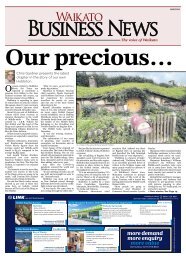Hamilton Grey Power September 2017
The Hamilton Grey Power Magazine is a localised edition of the National Grey Power Magazine, reporting on the policies of the Grey Power Federation, concerns of the elderly and reader interest articles which keep the members informed on issues that directly effect them.
The Hamilton Grey Power Magazine is a localised edition of the National Grey Power Magazine, reporting on the policies of the Grey Power Federation, concerns of the elderly and reader interest articles which keep the members informed on issues that directly effect them.
Create successful ePaper yourself
Turn your PDF publications into a flip-book with our unique Google optimized e-Paper software.
EBBETT HOLDEN NOT NEW BUT NEARLY!! ONLY FOUR MONTHS OLD SAVE THOUSANDS!! SEE PAGE 28<br />
Chlorination of water should be demanded<br />
FROM TOM O’CONNER<br />
<strong>Grey</strong> <strong>Power</strong> president<br />
AMID THE SCRAMBLE TO FIND THE SOURCE OF THE<br />
CAMPYLOBACTER CONTAMINATION IN THE HAVELOCK<br />
NORTH WATER SUPPLY, AND THE TSUNAMI OF BLAND<br />
ASSURANCES THAT THE EVENT WAS RARE BUT COULD<br />
HAPPEN ANYWHERE, SOME IMPORTANT FACTS MUST NOT<br />
BE OVERLOOKED.<br />
We don’t need excuses about the wisdom of hindsight<br />
to realise that this event was both predictable and<br />
avoidable, had two local government bodies been concentrating<br />
on their core responsibilities.<br />
The potential for contamination of the supply wells was too<br />
obvious to be overlooked and had been for some time. Managing<br />
risk to public health does not include the “do nothing option”<br />
in the hope that all will be well and that any problems will<br />
be discovered in time to take remedial action. The result of that<br />
attitude has been several thousand people taken seriously ill and<br />
the establishment of campylobacter infection in the Hawke’s Bay<br />
population which may take months if not years to eradicate.<br />
For the very young and elderly, this pathogen can be fatal.<br />
There will now no doubt be claims for compensation added<br />
to the cost of a total disinfection of the entire water reticulation<br />
system. These costs will probably far outweigh the cost of chlorination<br />
had it been installed.<br />
At 25 metres, the Havelock North wells are shallow enough<br />
for surface water intrusion from a number of sources in the right<br />
conditions. These sources include run-off from farming in the district<br />
and a number of environmental groups have often warned<br />
that the contamination of surface waters from an increase in intensive<br />
farming operations in recent years would eventually show<br />
up in aquifers used for domestic water supplies. The potential<br />
threat was well known. While regional councils are not responsible<br />
for the supply and quality of potable water, they are responsible<br />
for the protection of all other freshwater bodies. They are<br />
also responsible to ensure land-based operations such as farming<br />
and other industries have systems and rules in place to protect<br />
freshwater from overuse and contamination. .<br />
Another important potential source of contamination is the<br />
Waipawa River, a tributary of the Tukituki River, which flows close<br />
to Havelock North and probably has underground links to some<br />
of the aquifers of the region. Human sewage contamination of<br />
the Waipawa River has appeared on a number of occasions. In<br />
short, the Havelock North water supply should have been and<br />
could have been chlorinated as a precaution long ago.<br />
To be fair, Havelock North is not the only local authority which<br />
does not chlorinate domestic water supplies as a matter of<br />
course. However the usual justification is that supply wells are<br />
very deep and are considered to be secure from contamination.<br />
The Havelock North wells are not deep.<br />
Some people also object to the odour and taste of chlorinated<br />
water but, when used correctly, chlorine is undetectable. It is only<br />
required in minute amounts to remove dangerous pathogens and<br />
it is only when too much is applied that the taste and odour is<br />
noticeable. Modern technology now makes it much easier to get<br />
those details right.<br />
It is a strange contradiction that central government, which<br />
acted far too slowly in this case, is prepared to impose fluoride on<br />
communities to protect oral health and seems ready to impose<br />
local body amalgamations for supposed economic efficiency,<br />
both without public consultation, but has not, so far, insisted that<br />
all domestic water supplies are adequately treated to avoid the<br />
calamity created by the Havelock North failure. If we can’t trust<br />
district and regional councils to get this basic stuff right, perhaps<br />
it is time the Government issued clear instructions to disinfect all<br />
domestic water supplies regardless of source.<br />
Housing a Labour quest<br />
FROM: MP SUE MORONEY<br />
Housing has been the hot topic in <strong>Hamilton</strong> for months<br />
now and it was the focus of Labour Leader Andrew<br />
Little’s recent visit to <strong>Hamilton</strong>.<br />
From the lack of Pensioner Housing now available in <strong>Hamilton</strong>,<br />
to the 30 percent increase in <strong>Hamilton</strong> house prices in a year and<br />
the resulting rent increases for rotten, mouldy homes – Andrew<br />
Little heard it all. Two public meetings meant that Mr Little got to<br />
hear first-hand about how these issues are affecting local people.<br />
He heard from students sleeping in cars, families living in rotten<br />
rentals and older people concerned about pensioner housing<br />
options. Labour has a comprehensive plan to address the housing<br />
problems. A Labour Government will build more affordable<br />
housing; crack down on speculators and support people in need.<br />
These three issues need to be addressed by Government.<br />
Mr Little told <strong>Hamilton</strong>ians that his Government will build more<br />
state houses and also build affordable houses that it will sell to<br />
first home buyers. The KiwiBuild policy will be funded by a $2b<br />
“regenerating” fund that will see 100,000 affordable homes being<br />
built in New Zealand over 10 years. For many years, it has<br />
been Labour Governments that have addressed housing needs.<br />
New Zealand needs Labour again now.<br />
I took Mr Little to see two Crown Land sites that are currently<br />
lying idle as potential affordable housing developments. They<br />
are the dilapidated Jebson Place/Dey St State Housing property<br />
in <strong>Hamilton</strong> East and the abandoned Richmond Park school site<br />
in Melville. Both sites could “fit the bill” for Labour’s affordable<br />
housing policy.<br />
Sue Moroney<br />
<strong>Hamilton</strong>-based Labour List MP<br />
430 Ulster Street, <strong>Hamilton</strong><br />
sue.moroneymp@<br />
parliament.govt.nz<br />
07 839 6803<br />
suemoroney<br />
Authorised by Sue Moroney,<br />
Parliament, Wellington<br />
1160 - Moroney ad 88x50.indd 1 10/05/16 3:56 PM<br />
Community Waikato CEO Holly Snape briefs Labour Leader<br />
Andrew Little, Housing spokesperson Phil Twyford and local MP<br />
Sue Moroney on the history of the abandoned Richmond Park<br />
school.<br />
<strong>Hamilton</strong> greypower Magazine – <strong>September</strong> 2016 23


















